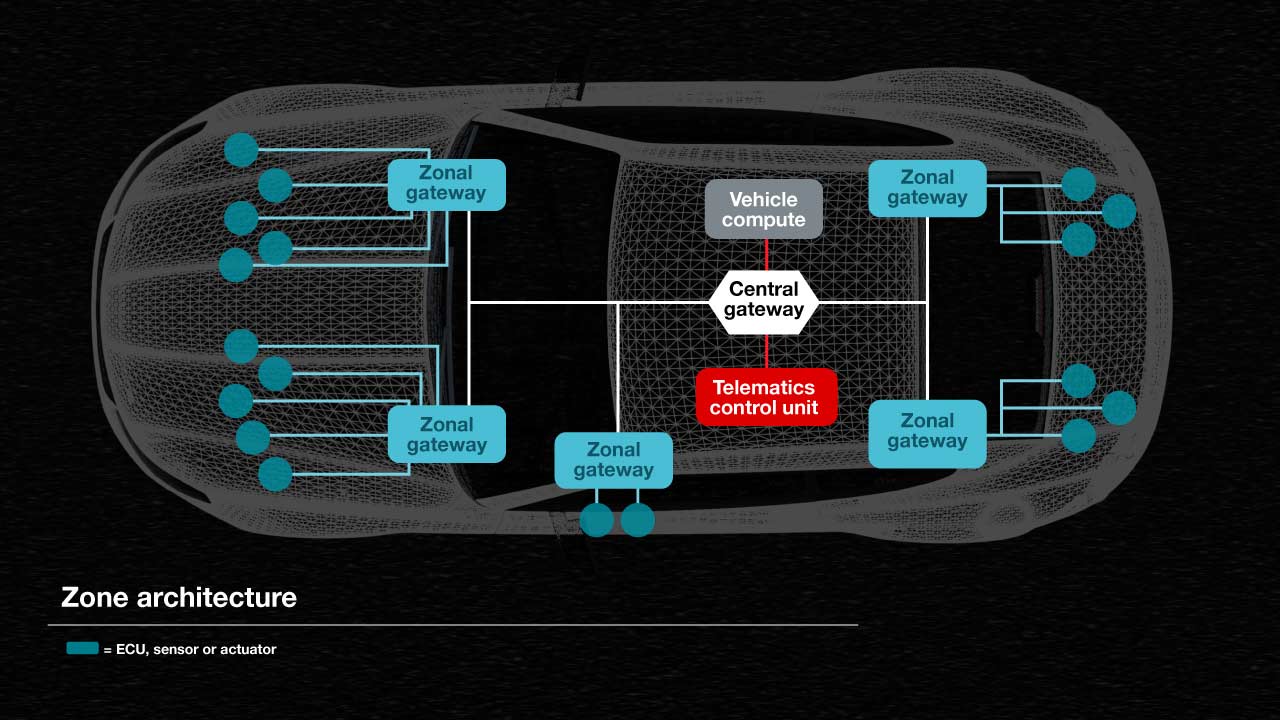SSZT227 november 2020 DRA821U
Automotive suppliers and original equipment manufacturers are heavily investing software R&D efforts on adding new functions and features to achieve autonomy, electrification and connectivity. Still, enabling these functions by adding more electronic control units (ECUs) is not sustainable when it results in increased complexity and cost.
There are two ways to consolidate and streamline ECUs within a vehicle: using a domain architecture or a zone architecture. A domain architecture consolidates a subset of the ECUs supporting a particular function of the car whereas a zone architecture consolidates ECUs based on their location in the car (ex: the right front zone). Though you could use both approaches to minimize system complexity and cost, a zone architecture streamlines processing and can help further minimize wiring within a car.
Figure 1 illustrates a zone vehicle architecture.
 Figure 1 A zone architecture with the
DRA821U as a central gateway or a zone gateway in the car
Figure 1 A zone architecture with the
DRA821U as a central gateway or a zone gateway in the carThe automotive industry has expressed how critical it is for gateway systems to support and bridge multiple interfaces. The DRA821 processor brings gateways with flexible vehicle networking to manage the exploding amount of data in vehicles. It has a rich and diverse set of networking interfaces including legacy CAN and LIN, high-speed PCI Express, and a time-sensitive networking (TSN)-enabled Ethernet switch to support zone architectures.
| Processing the Advantages of Zone Architecture in Automotive | |
Reference design
|
Read the article |
When leveraging the zone architecture for additional capabilities, you may encounter limitations when consolidating non-safety-critical and safety-critical ECUs. It’s important to keep mixed criticality (the ability to support safety-critical and non-safety-critical operations within one chip) in mind when suppliers move to minimize complexity while adding capabilities. In the case of gateways, mixed criticality helps maintain an effective network between zones, such as advanced driver assistance system compute module communicating with the braking system, while adding features like cloud connectivity.
TI has enabled mixed criticality by using extensive firewalls on DRA821 processors to achieve freedom from interference. The device has a total of four Arm® Cortex®-R5F microcontroller (MCU) cores that can support time-sensitive tasks and run in lockstep to support safety. Firewalling these MCU cores as well as the CAN/LIN interfaces, on-chip memory and double-data-rate interfaces from the rest of the chip can support safety-critical functions. Instead of using a separate application processor, you can leverage the dual Cortex-A72 cores isolated from the safety-critical functions for features such as managing the connection to the cloud to create novel business models and user experiences, including over-the-air updates and predictive maintenance. This separation of critical and non-critical functions using the freedom from interference enabled by the DRA821 encourages the integration of innovative features into the gateway while minimizing vehicle network complexity.
While performance requirements and features evolve, the goal of minimizing overall cost remains constant. Gateways require external Ethernet switches to support new vehicle architectures in addition to the safety MCU required for functional safety. The DRA821 can integrate the safety MCU and external Ethernet switch to achieve system cost savings while also enabling zone-based vehicle architectures, as shown in the “Automotive and IoT Gateway Reference Design Based on the Jacinto DRA821 Processor” reference design.
With years of experience in the automotive industry, we know that scaling our customers’ software efforts across different performance points is important. Instead of starting from scratch with another processor, the ability to reuse software allows automotive suppliers to minimize software R&D and reduce time to market. The DRA821 aims to enable advanced networking for vehicles across a broad range of central, domain or zone gateways.
The road to safer, cleaner and more connected vehicles brings many challenges. Suppliers must manage growing system requirements as they continue to innovate while being cognizant of system cost and complexity. With a scalable performance offering and an evaluation module to start software development, the DRA821 is a system-on-chip that brings efficient networking and mixed criticality to feature-rich vehicle gateway systems.
Watch the video to learn more.